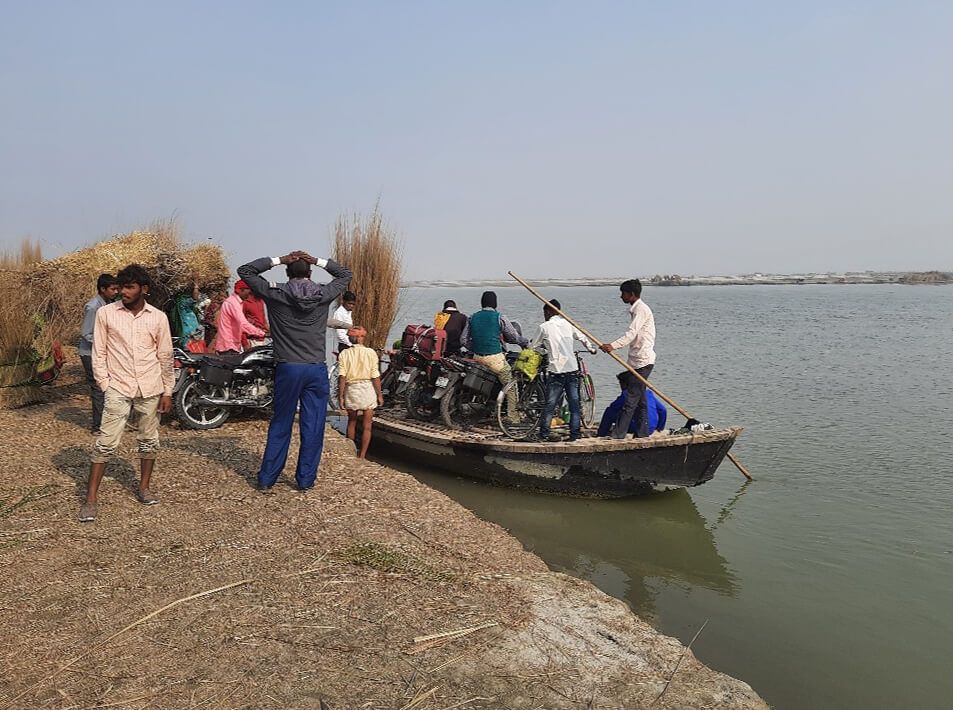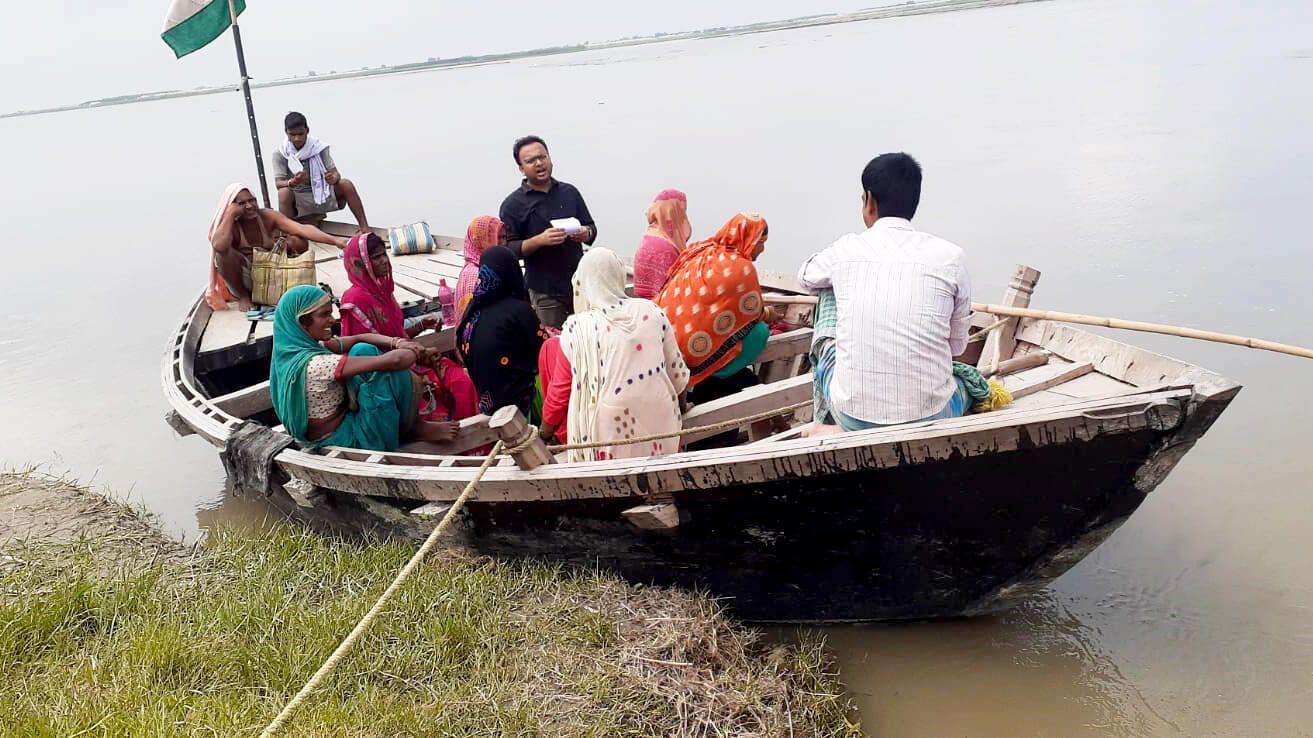The Koshi River in northern India is a transboundary river that flows through Tibet, Nepal and India. It is the lifeline of communities that live along its banks. But the river landscape is changing rapidly due to climate change and other human activities.
In this series, Rahul Yaduka finds out about the challenges unique to the Koshi River in India, the government’s water management strategies and citizens’ responsibilities and adaption measures.
In this first story, Rahul Yaduka visited the communities along the Koshi River to learn about the challenges communities are facing and how they are responding to the changing river landscape.
The Koshi River is famously known as the “river of sorrow” in India. Every year it brings large-scale devastation in the state of Bihar due to floods. However, for me, Koshi is a river that hides a thousand stories.
The Koshi River is famously known as the ‘river of sorrow’ in India. Every year it brings large-scale devastation in the state of Bihar due to floods. However, for me, Koshi is a river that hides a thousand stories.
Today, I visit Balwa, a village in Supaul district of Bihar, close to Nepal as a part of my research work. Dharmendra, a full-time member of Koshi Navnirman Manch (KNM), a people’s movement to safeguard the interests of the people living on the banks of Koshi, accompanies me. He plans to meet people in the village to mobilise them against an ongoing land survey in Bihar that threatens to dispossess the people of their private lands.
We start on a motorbike from the district headquarters and head towards Ghuran ghaat, the riverbank, from where we have to take a boat to cross a stream of the river.
It had been raining incessantly for the last 10 days. On the way to Ghuran, we cross many roads damaged by the floods of the previous month. At least thrice I get off the motorbike and walk through knee-deep water, while Dharmendra struggles to push the motorbike.
After parking the motorbike, we walk for about one kilometre along bhitta, the interface of the river and the immediate landmass exposed to erosion, locally called kataniya. Those living near the bhitta are the most vulnerable to the flooding of the river.
However, by the time we reach the boat station, we are too late. Now we need to wait for more than two hours for the next boat. The government doesn’t facilitate the ferrying of people across the rivers.
When the river swells during the monsoon, inundating landmasses, private and community-owned boats and mechanised steamers remain the only mode of transport. From grass, animals, bikes and even tractors – everything is transported in them.
While waiting for the boat, I talk to a farmer working in his field nearby. I notice shafts of tall wood. Dharmendra tells me that the crop is called manejar, a kind of wood. I meet a farmer named Mahendra Yadav, who tells me that manejar is a termite-resistant wood, and is used for building huts in the region.
Earlier I had met Ranjiv in Patna, the capital of the state of Bihar. He is an activist working for rivers in Bihar. He had told me that manejar was introduced in the region exogenously during Green Revolution in the 1960s. It grows in the marshy land and decomposes there, creating a field rich with organic material.
While waiting for the boat, I meet some women, who tell me about the problems they face due to floods, like lack of basic amenities, including toilets, schools and hospitals. They ridicule the government’s claims of providing relief to the people. They recall how in the absence of toilets they have to defecate standing in the river itself during the monsoon.
During floods, water enters the courtyard, and they stack cots made of wooden planks for shelter and sit there for three days. Probably, this is what real ‘resilience’ means.
Finally, our boat arrives and we are ready to cross the river.




There is much commotion. Dharmendra tells me that paying money for the boat ride is not a convention. Not all boat operators charge, and not all people pay. Those crossing the river occasionally are considered guests and not charged. Also, interestingly, people pay the fare either while going to the village or returning from it.
The weather is cool and breezy, and it might rain anytime. Hardly 10 minutes after the boat leaves the bhitta, it starts raining. We see the clouds approaching us from distant villages. I am thrilled and also afraid. Thrilled because I have never experienced rain while on a boat, and afraid because I have no umbrella or raincoat. I am worried about my mobile phone because it has many field photographs that I have taken over eight months of my field study.
As it rains heavily, Dharmendra and I hide behind the banner we are carrying for the meeting. It does not save us for long. When we get off the boat, I feel exhausted to know that we have to walk in muddy land for around 30 minutes to reach the primary school of Balwa, where Vikas, another member of KNM, has made people wait since noon. Vikas has organised a meeting with the local people in his village Balwa regarding the survey. He also mobilised them for a door-to-door campaign.
The rain intensifies. At one point, we literally swim to reach Balwa. Small streams of the river interject our path and we wade through them.
The rain has caused waterlogging. Dharmendra tells me that wading through water, and almost swimming, are nothing unusual in the region.
By the time we reach Vikas’s house, we are completely drenched. He offers me tea. And I get my mud-soaked clothes washed.
We finally hold the meeting in the so-called school, which is barely a hut. I address the people and explain the contentious provision of the survey rules.
People in the Koshi region of Bihar have been resisting some specific provisions of the survey rules. The bone of contention is that the land submerged by the river flow will become the state's land. They want to know whether the land which resurfaces in the coming years from the bed of Koshi will be reallocated to the raiyat, the farmer who cultivates his own land.
Technically, this is the norm that land under river flow is the state's property as it carries the common interest of the entire population. It is also essential to utilise the river water to produce electricity, use it for irrigation and develop waterways.
However, Koshi’s case is peculiar. It flows like a pendulum and may hover over any piece of land within the embankments. Koshi had flown over every inch of land in the past two centuries from Purnea district in the east to Darbhanga district in the west before it was forcibly tamed within the embankments after independence.
After the meeting, we come back to Vikas’s house. I am hungry, but there are no markets or shops nearby. And it starts raining again.
Then unexpectedly, we are served fried choora, an all-time favourite multipurpose snack of the Koshi region made from rice. Choora or flattened rice is a popular food here because it has an excellent shelf life, fills the belly as it soaks water and can be easily carried and consumed on the way with curd (yogurt), sugar and milk and can be fried with oil as well. People survive the flood period on choora.
The government also distributes choora during relief work after the floods. We feel satiated and warm after having a cup of tea again. The culture of feeding the guests (even when visiting uninvited) is something that I appreciate in the region. In a place where there are no markets and money doesn’t help, you realise the significance of community.
While rowing back to the Ghuran chowk, we meet an old lady, one young woman and two men. All of them are teachers of that school. Dharmendra winks at me and tells me that Vikas teaches in place of them and gets a commission. These teachers don’t bother to come beyond the embankments.
On my journey back to the Supaul office, I feel numb. With my experience on a single day, the hardship the people face on an everyday basis sinks in.
All promises of the modern welfare state were laid bare in front of my eyes. All promises of shining India were enveloped in darkness. Still, I am happy to meet simple-minded people with deep gratitude for whatever nature throws at them. This is my biggest lesson in sustainable development.




